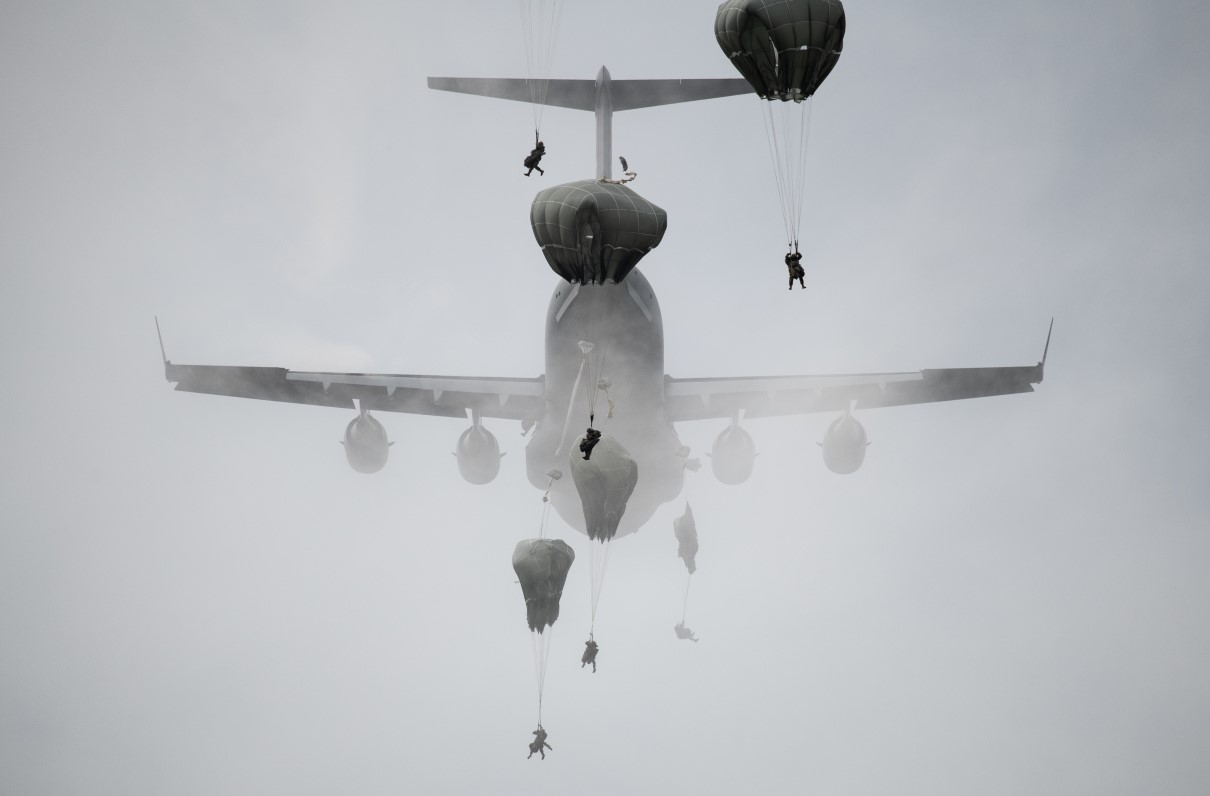(This article originally appeared in the February 2023 issue of Military Officer, a magazine available to all MOAA Premium and Life members. Learn more about the magazine here; learn more about joining MOAA here.)
The Army’s 11th Airborne Division is flying once again. This time, the 11th Airborne will be operating on the Arctic ice, rather than making jungle rescues as the paratrooper and glider group of the same name did while playing pivotal roles in the Pacific theater of World War II and the Korean War.
The newly reactivated 11th Airborne Division has airborne and air assault capabilities, like the Army’s 82nd and 101st Airborne divisions.
Its mission is to become the Army’s preeminent Arctic force, prepared to combat enemies in extreme environments.
In the Army’s effort to modernize and adapt to both the Arctic climate and the changing threats in the Pacific region, the former 1st and 4th Brigade Combat Teams (BCTs) of the 25th Infantry Division now comprise the new 1st and 2nd Infantry BCTs of the 11th Airborne.
The 11th Airborne and its 1st and 2nd BCTs were activated in ceremonies on June 6, 2022, the 78th anniversary of D-Day. The 1st Brigade’s home is Fort Wainwright, and 2nd Brigade is homestationed at Joint Base Elmendorf-Richardson.
The 11th Airborne patch bears the wings of the Arctic Airborne and is based on the 11th Airborne patch from the World War II era.
“Our purpose and identity have been given to us with the 11th Airborne [designation],” Maj. Gen. Brian Eifler, USA, commander of the 11th Airborne Division and U.S. Army Alaska (USARAK), told Military Officer. “It is really special. There is excitement about serving here again that we probably haven’t seen here in three decades.”
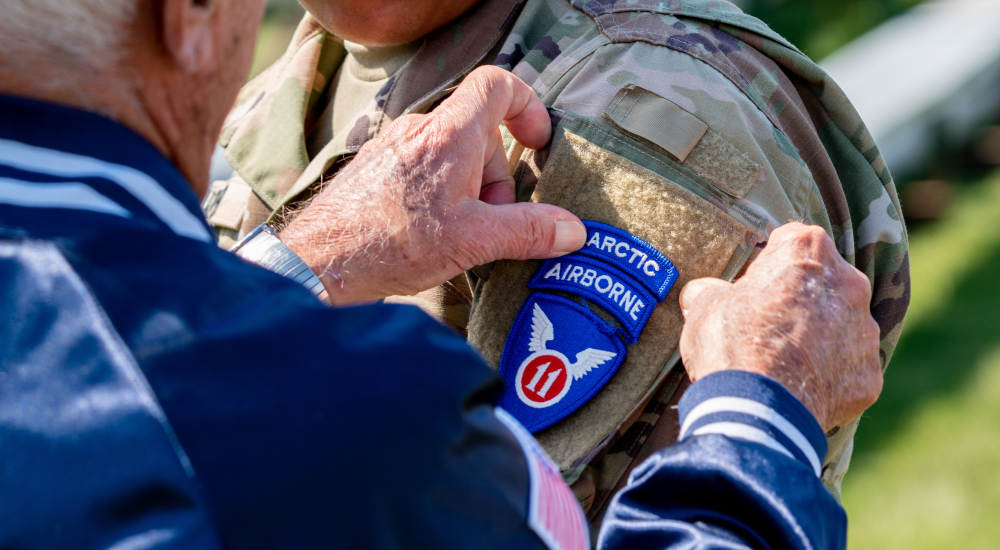
Wayne Porter, an Army veteran who was assigned to the 11th Airborne Division before its deactivation in 1958, places an 11th Airborne Division shoulder sleeve insignia on Spc. Jihad Yarber, assigned to the 2nd Brigade, 11th Airborne Division, during the reflagging ceremony of the 11th Airborne Division on June 6, 2022, at Pershing Parade Field, Joint Base Elmendorf-Richardson, Alaska. (Photo by Senior Airman Patrick Sullivan/Air Force)
Alaska has renewed strategic importance for the U.S. military, as Russia reinforces its military presence in the Arctic due to the impact of global climate change and China expands as a military powerhouse in the Pacific region and beyond.
The Arctic is home to an estimated 13% of the world’s oil and 30% of its natural gas, according to the Army’s Arctic strategy, published in 2021. “There are places in the world where we need our soldiers to be able to fight in negative 30-degree weather,” Army Secretary Christine Wormuth told Military Officer. “And the Arctic is becoming a more competitive arena. As the polar caps melt and the shipping lanes open, there are more countries interested in that region economically, and certainly Russia has absolutely militarized places where they can. So I think it is important that we have a presence there.”
With the reactivation of the 11th, Eifler said, “the nation will benefit from it by having a more ready force up here [that’s] more capable and more of a deterrent to our adversaries.”
A New Cold War?
During the Cold War, Alaska was a strategic missile site for the Air Force and Army, serving as a deterrent to aggression by the former Soviet Union with its stockpile of nuclear weapons.
The military in Alaska regularly conducted extreme cold weather training in anticipation of potentially fighting in Alaska or similar extreme environments. For example, in 1965, the U.S. conducted exercise Polar Strike in Alaska, and more than 14,000 Army and Air Force personnel joined Canadian forces to test their air mobility and survival skills.
When Lt. Col. Dusty Finley, USA (Ret), now the 11th Airborne Division deputy chief of staff, served as a scout in the Alaska Army National Guard in the 1980s, he and fellow soldiers would often have to improvise when it came to surviving and communicating during their cold-weather training.
Soldiers would sleep with their water bottles on their person so the water wouldn’t freeze. They would wear the batteries from their radios inside their uniforms to keep the batteries warm.
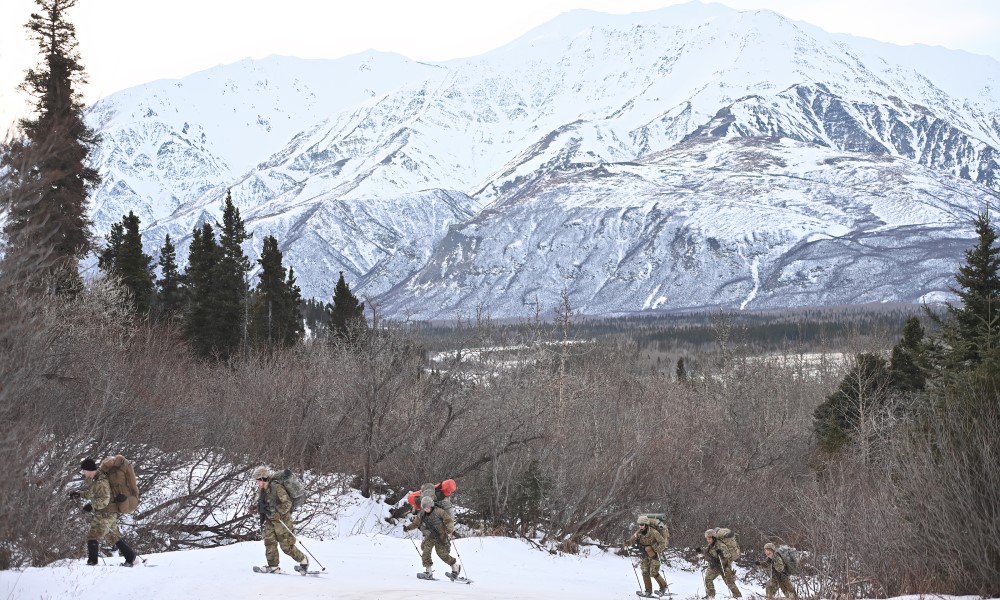
Cold Weather Orientation Course students from the 11th Airborne Division head out for a snowshoe trek during training at the Northern Warfare Training Center’s Black Rapids Training Site. (Photo by John Pennell/Army)
Things began to change in Alaska when the U.S. military increased its focus on the Middle East after the terrorist attacks of Sept. 11, 2001. Deployments to Afghanistan and Iraq for two decades limited USARAK’s ability to train its soldiers in extreme cold weather, Eifler said.
“The brigades and the units here … were rotating back and forth,” Eifler said. “Year on, year off, year on, year off. So how much winter training are you really doing?”
The Army saw it was time to expand its presence and stand up a unit in Alaska whose soldiers were trained to conduct a broad range of missions in cold-weather and high-latitude environments.
“Once again, we have strategic interest in Alaska that must be defended in the name of national security,” Finley said.
Shaping the New 11th
Along with establishing an operational command at Joint Base Elmendorf-Richardson and Fort Wainwright, the 11th is acquiring weather-resistant equipment and lining up more training opportunities for soldiers.
As it begins the process of outfitting its soldiers, USARAK will “flesh out the 11th Division staff and other needed positions within the division,” Eifler said.
“More structural changes are in store as the 11th Airborne Division staff is formed, and division artillery, aviation, and support units stand up,” he said.
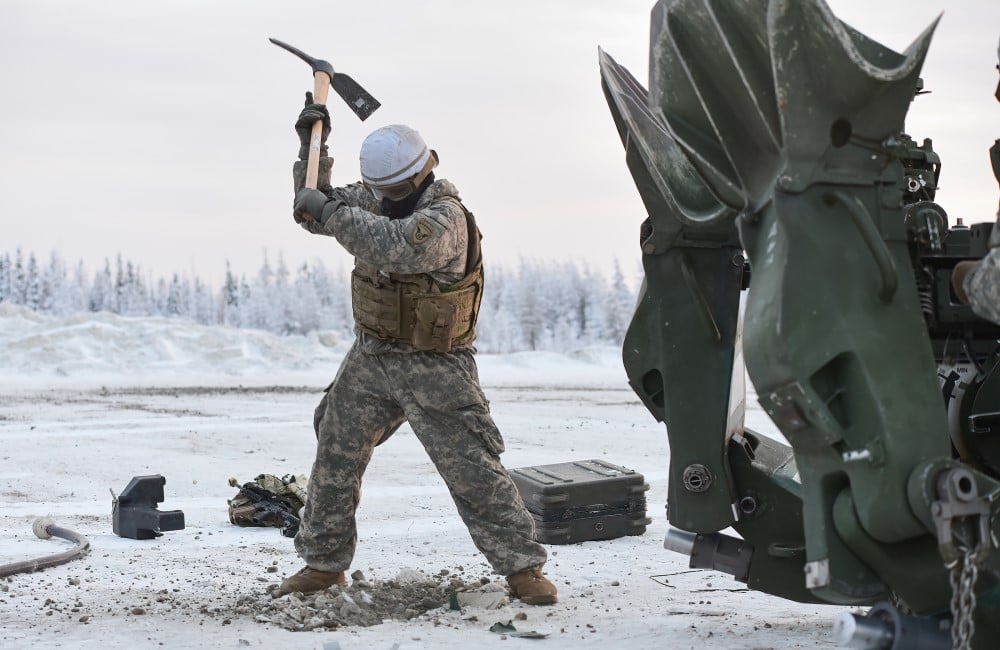
Spc. Andre Scott, C Battery, 2nd Battalion, 8th Field Artillery Regiment, 1st Brigade, 11th Airborne Division, uses a pickaxe to dig in the M777 howitzer’s spades in the frozen, rocky soil of Firing Point 26 on Fort Wainwright, Alaska. (Photo by John Pennell/Army)
The 1st BCT, formerly a Stryker brigade, is now a light infantry brigade focused on air assault. The 1st BCT, combined with the 4,000 paratroopers in the 2nd BCT, aims to be an agile fighting unit.
“Over-snow, mountain and high-altitude maneuvering capabilities will be key for the Arctic Angels,” Eifler said. “This will include airborne and air-assault tactics, along with more Arctic-unique tactics, techniques, and procedures.”
Cold-weather exercises are essential to becoming battle-ready in harsh environments where the terrain is rugged and the effectiveness of soldiers’ technology, like cellphone batteries, can sometimes be measured in minutes, not hours, Finley said.
In the past two years, USARAK has conducted cold-weather exercises and has been working with countries such as India and Nepal to plan training opportunities, including possibly one on Mount Everest, Eifler said.
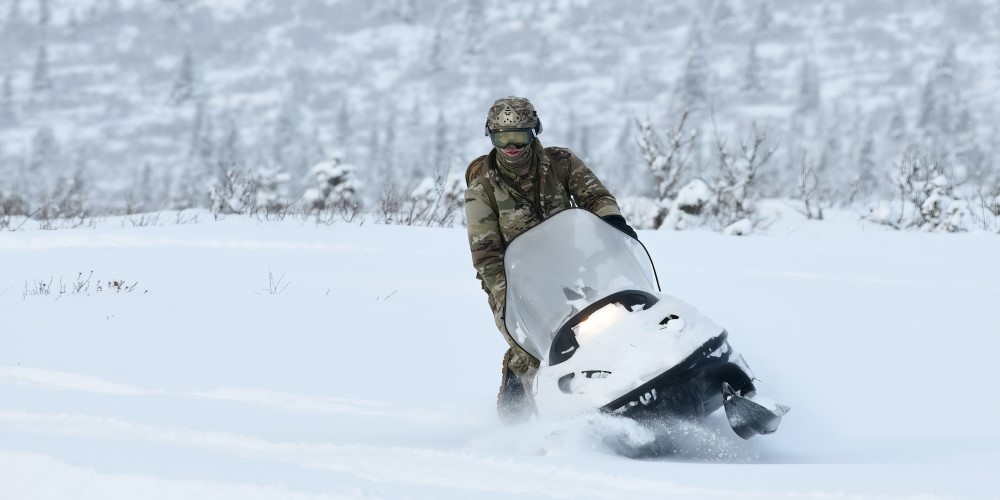
A medic with 725th Brigade Support Battalion (BSB) patrols during U.S. Army Alaska training in March 2022. 725th BSB (Airborne) is now part of the 2nd Brigade Combat Team, 11th Airborne Division. (Photo by John Pennell/Army)
Soldiers are being supplied with new Beowulf Cold Weather All-Terrain Vehicles (CATVs) as well as snowmobiles, skis, snowshoes, and other equipment.
The CATVs are designed to move over many types of terrain and operate eff ectively in extreme cold weather.
“We plan to air drop those machines with the troops, much like we have already been air dropping howitzers, Humvees, and Small Unit Support Vehicles. They can also be slung underneath our helicopters for transport,” Eifler said.
As part of the transition to more cold-resilient technology, last fall, the 11th shipped out the last of its Stryker vehicles, which often struggled to operate in cold environments where temperatures regularly dip below zero.
A new unit and new equipment are expected to help boost the soldiers’ combat readiness and their morale.
“We are already starting to hear from soldiers that with the reestablishing and the new patch, that they have more of a sense of identity, which I think is good for morale,” said Wormuth, the Army secretary, who along with other Army leaders is working on initiatives to improve behavioral health resources and quality of life for soldiers in Alaska.
As the soldiers known as Arctic Angels bring to life the new iteration of the 11th Airborne, appreciation has grown for those 11th Airborne warriors who fought and died for their country more than a half century ago.
Carrying on the Legacy
The original 11th Airborne — comprising parachute infantry, glider infantry, parachute field artillery, and glider field artillery — was renowned for helping free thousands of prisoners of war from a Japanese internment camp in the Philippines in 1945.
After serving valiantly in the Korean War, the 11th was converted to an air assault training division stateside before becoming the 1st Cavalry Division (Airmobile) during the Vietnam War.
A few members of the 11th Airborne Division Association attended the 11th’s reactivation ceremony on June 6, 2022. They said they were delighted with the reception they received from the soldiers stationed there.
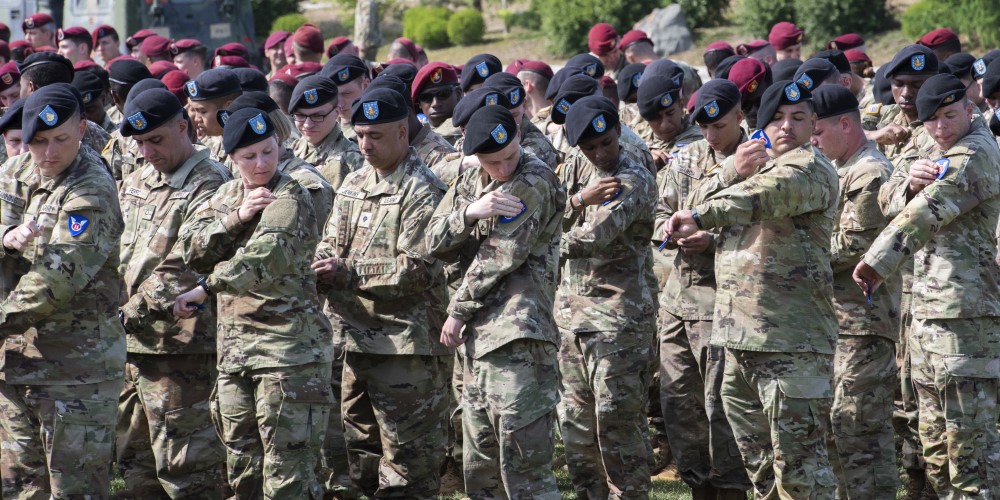
Soldiers place their new Arctic Angels patches on their left shoulders during the activation of the 11th Airborne Division at Pershing Parade Field, Joint Base Elmendorf-Richardson, Alaska, on June 6, 2022. (Photo by Sheila deVere/Air Force)
With association membership shrinking — the average member is now in his late 80s — President Joe Doshier is thrilled to see the new 11th becoming one of America’s premier fighting units.
“I was privileged to go [to the reactivation ceremony],” said Doshier, who was an Army private first class. “We are not going to die, not this association.”
“A lot of people don’t know about the great, amazing history [of the 11th],” Eifler said. “The veterans’ group for the 11th has new life. They are so excited that we can relive their history, and it’s very important to communicate that to our soldiers.”
